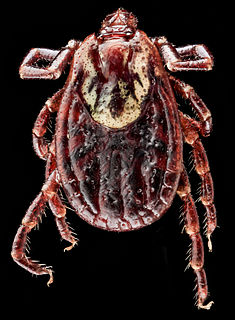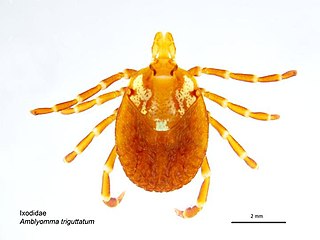
Rocky Mountain spotted fever (RMSF) is a bacterial disease spread by ticks. It typically begins with a fever and headache, which is followed a few days later with the development of a rash. The rash is generally made up of small spots of bleeding and starts on the wrists and ankles. Other symptoms may include muscle pains and vomiting. Long-term complications following recovery may include hearing loss or loss of part of an arm or leg.

Ticks are parasitic arachnids that are part of the superorder Parasitiformes. Along with mites, they constitute the subclass Acari. Adult ticks are approximately 3 to 5 mm in length depending on age, sex, species, and "fullness". Ticks are external parasites, living by feeding on the blood of mammals, birds, and sometimes reptiles and amphibians. It is estimated ticks originated during the Late Cretaceous period, approximately 120 MYA, the earliest tick fossil in New Jersey amber is dated at 90-94 million years old. Ticks are widely distributed around the world, especially in warm, humid climates.

Dermacentor variabilis, also known as the American dog tick or wood tick, is a species of tick that is known to carry bacteria responsible for several diseases in humans, including Rocky Mountain spotted fever and tularemia. It is one of the best-known hard ticks. Diseases are spread when it sucks blood from the host. It may take several days for the host to experience symptoms.

Amblyomma is a genus of hard ticks. Some are disease vectors, for example the Rocky Mountain spotted fever in Brazil or ehrlichiosis in the United States.

Amblyomma americanum, also known as the lone star tick, the northeastern water tick, or the turkey tick, or the ‘’Cricker Tick’’, is a type of tick indigenous to much of the eastern United States and Mexico, that bites painlessly and commonly goes unnoticed, remaining attached to its host for as long as seven days until it is fully engorged with blood. It is a member of the phylum Arthropoda, class Arachnida. The adult lone star tick is sexually dimorphic, named for a silvery-white, star-shaped spot or "lone star" present near the center of the posterior portion of the adult female shield (scutum); adult males conversely have varied white streaks or spots around the margins of their shields.
Ehrlichia chaffeensis is an obligate intracellular, Gram-negative species of Rickettsiales bacteria. It is a zoonotic pathogen transmitted to humans by the lone star tick. It is the causative agent of human monocytic ehrlichiosis.
Ehrlichiosis ewingii infection is an infectious disease caused by an intracellular bacteria, Ehrlichia ewingii. The infection is transmitted to humans by the tick, Amblyomma americanum. This tick can also transmit Ehrlichia chaffeensis, the bacteria that causes human monocytic ehrlichiosis (HME).

Ixodes pacificus, the western black-legged tick, is a species of parasitic tick found on the western coast of North America. I. pacificus is a member of the Ixodidae (hard-bodied) family. It is the principal vector of Lyme disease in that region. I. pacificus typically feeds on lizards and small mammals therefore its rate of transmission of Lyme disease to humans is around 1% of adults. It is an ectoparasite that attaches itself to the outside of its host and feeds on the hosts blood meal. It can have a heteroxenous lifestyle or monoxenous life cycle depending on how many hosts it feeds on in each cycle. I. pacificus has a four stage life cycle that takes around 3 years to complete. These stages include egg, larva, nymph, and adult. They prefer dense woodland habitats or areas of brush and tall grass.

African tick bite fever (ATBF) is a bacterial infection spread by the bite of a tick. Symptoms may include fever, headache, muscle pain, and a rash. At the site of the bite there is typically a red skin sore with a dark center. The onset of symptoms usually occurs 4–10 days after the bite. Complications are rare, but may include joint inflammation. Some people do not develop symptoms.

Ticks of domestic animals directly cause poor health and loss of production to their hosts. Ticks also transmit numerous kinds of viruses, bacteria, and protozoa between domestic animals. These microbes cause diseases which can be severely debilitating or fatal to domestic animals, and may also affect humans. Ticks are especially important to domestic animals in tropical and subtropical countries, where the warm climate enables many species to flourish. Also, the large populations of wild animals in warm countries provide a reservoir of ticks and infective microbes that spread to domestic animals. Farmers of livestock animals use many methods to control ticks, and related treatments are used to reduce infestation of companion animals.

Amblyomma triguttatum, commonly known as the kangaroo tick, is a species of tick in the genus Amblyomma native to Australia. There are four subspecies, one or more of which might be separate species. The nominate subspecies is a vector for Rickettsia.
The Asian tortoise tick, is a hard-bodied tick of the genus Amblyomma. The tick is a parasite of tortoises, such as Geochelone elegans, domestic dogs, buffaloes. It is found in India, Sri Lanka and Myanmar. Adult tick is about 3 cm in length.
Amblyomma gervaisi is a hard-bodied tick of the genus Amblyomma. The tick is a parasite of snakes, such as Naja naja, Python molurus species and monitor species such as Varanus ocellatus, Varanus yemenensis, Varanus benghalensis, Varanus griseus and many other Varanus species in southeastern Asia and Asia-minor. They exhibit sexual dimorphism. They can be found in Sri Lanka, India, Yemen, Saudi Arabia. It is a potential vector for Coxiella burnetii.
Amblyomma javanense is a hard-bodied tick of the genus Amblyomma. It is found in Vietnam, Indonesia, Malaysia, India, Sri Lanka, Philippines and Thailand. It is the only ectoparasite found on the Manis javanica, Manis crassicaudata and also from Sus scrofa.

Amblyomma testudinarium is a hard-bodied tick of the genus Amblyomma. It is found in Indonesia, India, Japan, Thailand, Sri Lanka and Vietnam. Adults parasitize various larger mammals such as buffalo and cattle, whereas nymphs and larvae use mostly larger and medium mammals.
The Goanna tick,, is a hard-bodied tick of the genus Amblyomma. It is found in Papua New Guinea, Australia, Indonesia, Solomon Islands, Sri Lanka. It is an ectoparasite of Equus caballus.
The Asian monitor lizard tick, is a hard-bodied tick of the genus Amblyomma. It is found in India, Thailand, Taiwan and Sri Lanka. Adults parasitize various reptiles such as varanids and snakes. These ticks are potential vectors of spotted fever group (SFG) rickettsiae.
Nosomma monstrosum, is a hard-bodied tick of the genus Nosomma. It is found in India, Bangladesh, Sri Lanka and Vietnam.

Cosmiomma is a genus of ticks first discovered by Paul Schulze in 1919. It is monospecific, being represented by the single species Cosmiomma hippopotamensis. It was first described in 1843 by Henry Denny from specimens collected from a hippopotamus in Southern Africa, and has been called "one of the most unusual, beautiful, and rare tick species known to the world."











